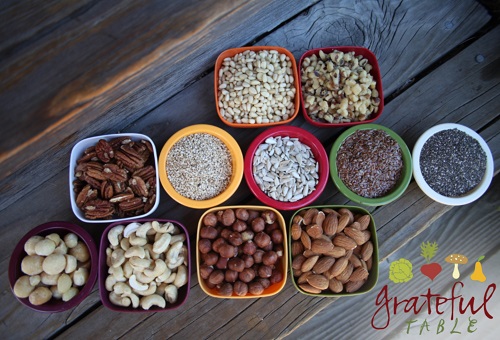There’s a lot of info below, but the main point is: Omega Six is Nix! Contrary to all we’ve heard, the overload of polyunsaturates in the modern diet leads to inflammation. I’ve experienced this first-hand. After balancing my diet with more Omega 3s (from salmon, cod liver oil, meats, butter and such, mainly), I had a huge change in my inflammatory conditions. My “thermometer” was my knees, which had become ridiculously swollen most of the time. That disappeared. The only time it came back was when our avocado crop came in. I unwittingly ate way too many avos (whoops!). I won’t do that again. The results are too amazing…
Below is a picture of foods with a lot of polyunsaturates in them. Which means they are high in Omega 6’s (but less so that the oils derived from them). I posted here on the dangers of PUFAs, and here about how you don’t want to cook with most of them. But at least the ones pictured today are in whole-food form! I set them up in order of their PUFA content per hundred grams (as listed here, at the US National Library of Medicine National Institutes of Health). Macadamias are the winner, with only 1.5 grams of PUFAs. From there we have cashews (7.8), hazelnuts (7.9), almonds (12), and pistachios (13). The next row are all in the 20-something range: pecans, brazil nuts, pumpkin, sesame seeds, hemp, sunflower, flax, and chia seeds. Top row is more extreme: pine nuts clock in at 34, and walnuts at 47.
Did I mention that we don’t want to obsess?! Stressing out about the exact amount of PUFAs in any given handful of nuts is not the answer. But I have become a bit more careful about making a meal of those nuts. Yes, I was kind of a nut freak- I could eat almost a half cup of them instead of a meal. I ate a lot of vegetarian meals, and figured nuts were a great source of calories, in whole-food form.
Now I use nuts more as a garnish on top of something, sprinkling chopped nuts or toasted seeds on top of soups or salads for extra texture. I’ve starting using macadamias more often than pine nuts and walnuts, since they’re about the lowest in polyunsaturated fatty acids. My inflammatory symptoms have simmered down; I suspect this dietary change had a lot to do with it.
Dr. Weil’s website is loaded with info. This page on “balancing Omega 3 and Omega 6 tells you more. Chris Kresser, M.S., L.Ac has a good article too (…”Not Enough Omega 3 is Making Us Sick!“). To sum it up: Our bodies need both Omega-3 and Omega-6, but they need balanced amounts. There are tons of sources of Omega 6 in our diets (thanks, junk food). But Omega 3’s are harder to come by, coming mainly from the fat of cold water fish (salmon, sardines, herring, mackerel, black cod, bluefish). Walnuts and flax seeds contain a form of omega-3 that we don’t readily convert into the form we need, so they can’t really resolve an Omega 3 deficit very effectively.
Not that Omega 6’s are useless. We make hormones from them. But the hormones we make with omega-6 fatty acids typically increase inflammation. This is a good thing in small quantities–it helps our immune response, blood clotting, and cell proliferation. Omega-3 fatty acids, on the other hand, help us make hormones that decrease those functions. When the two oils are in balance, we have the best of both worlds.
There’s been all kinds of talk about inflammation in our house this past year. My dad’s research revealed that the cholesterol deposits accumulating in the wrong places in my mom’s brain were not the actual problem, but a symptom. The cholesterol proliferates when there is inflammation. It’s a response to the inflammation. So let’s go after the real bad guy! Cholesterol just happened to be there–it doesn’t mean it committed the crime.
I even found out that my hypothyroidism was related to inflammation. OK, now I’m listening!
In any case, as mentioned on Dr. Weil’s website, the dietary imbalance between the two Omegas might explain the increase we’ve seen in a lot of diseases: asthma, heart disease, cancers, autoimmunity, and neurodegenerative.
That imbalance might also increase obesity, depression, dyslexia, hyperactivity and even violence. In one study, taken in a British prison, violence dropped by 37 percent after omega-3 oils and vitamins were added to the prisoners’ diets. That’s some powerful Omega!
It’s not just affecting us. Commercially raised animals are pumped full of corn and soy (yipes- totally GMO), so they get too much omega 6 (and not enough omega 3). The resulting meat reflects that unbalance. Get free-range, grass-fed, organic meat to avoid that.
If you are going to cook with nuts and seeds, the following make good choices: Cashews, macadamia, filberts, almonds, and pistachios; be more careful with sunflower, sesame, pumpkin seeds and walnuts, as they can’t take much heat.
Like I said, we don’t want to get too obsessed. But I am eating more Omega 3s from healthy sources (salmon, grass-fed beef and free-range chicken). The American Institute for Cancer Research has noted that Omega-3s may decrease the onslaught of heart disease, dementia, arthritis, diabetes, and cancer. I’m down with that!
And I’m eating a few less nuts now. Working to keep the omega 3/6 balance in check. My inflammatory conditions seem to have lightened up. Yay!


2 Responses to “Omega 6 Takeover Battles Healthy Omega 3- Shoot for Balance!”